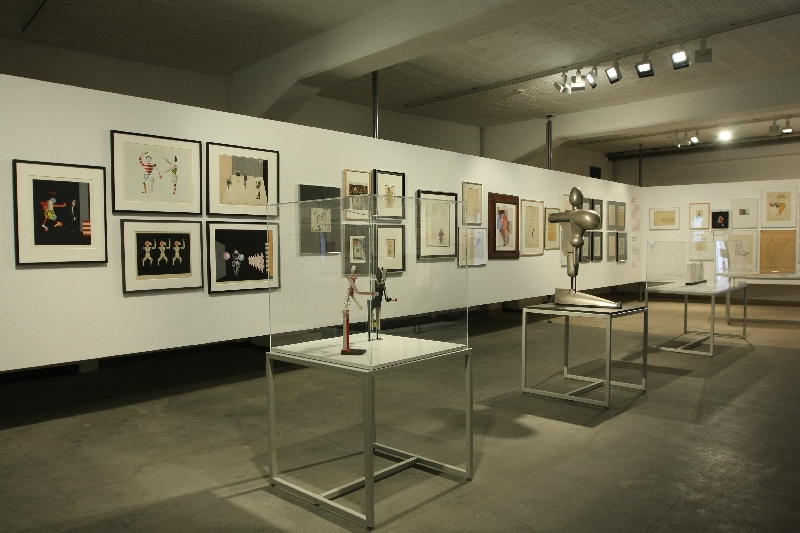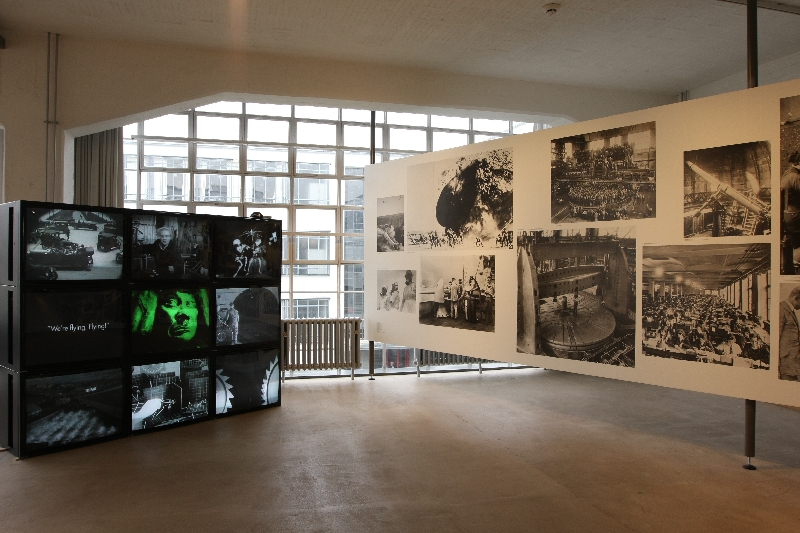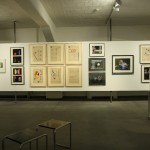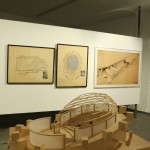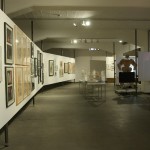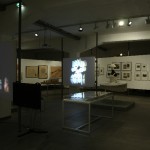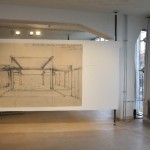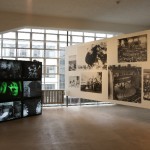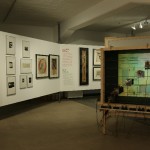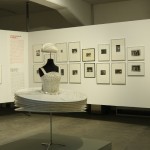Stiftung Bauhaus Dessau: “Mensch Raum Maschine. Stage Experiments at the Bauhaus”
While we can’t be certain that the artist, designer and choreographer Oskar Schlemmer would have completely agreed with the claim that “Life is a cabaret”, we do know where he placed cabaret in the great scheme of cultural happenings: a little lower than theatre, but slightly higher than varieté.
“”Stage” in general”, Schlemmer wrote in 1925, “encompasses all that lies between religious cult and naive public amusement, both are not that what the stage is; the calculated impact on man of naturally abstract performances”1
A description which wonderfully describes the Bauhaus Stage, an institution which Oskar Schlemmer led from 1923 until 1929, and which he dominated like no other.
Established by Walter Gropius in 1921 the Bauhaus stage has remained a rarely explored aspect of the Bauhaus story, at least publicly. Less on account of a lack of interest, but much more on account of a legal dispute between Oskar Schlemmer’s heirs over the use, or more commonly non-use, of Schlemmer’s estate. A dispute that has made organising any form of Schlemmer related exhibition very difficult. And so something most museums have sensibly chosen to avoid.
And while, yes, it would be possible to organise a Bauhaus Stage exhibition without making toooooo much mention of Oskar Schlemmer, that would be a bit like organising a sugo arrabiata without making toooooo much use of chilli.
Possible. But pointless.
On December 31st 2013 the copyright to Schlemmer’s legacy expires, the power of his more negatively inclined heirs fades, and consequently we can expect a lot more Oskar Schlemmer exhibitions and books in the coming years.
The Stiftung Bauhaus Dessau have seized the initiative and until April 21st 2014 are presenting the exhibition “Mensch Raum Maschine. Stage Experiments at the Bauhaus”, an exhibition devoted to the Bauhaus Stage.
Divided into seven sections covering topics such as “Sculptural Choreographies”, “Atmospherical Devices” or “Eccentric Stage Mechanisms”, Mensch Raum Maschine is the first dedicated, concentrated, exploration of the Bauhaus Stage and its protagonists. Largely based on graphics, photos and related 2D visual media, Mensch Raum Maschine also makes use of film, costumes, machinery and models to help explain what the Bauhaus Stage was and how it functioned. In addition to Oskar Schlemmer the exhibition features “contributions” from the likes of T. Lux Feininger, Johannes Itten, Herbert Bayer, Wassily Kandinsky, Marianne Brandt, László Moholy-Nagy and Walter Gropius.
Having explained the historic Bauhaus Stage, Mensch Raum Maschine then moves on to present three contemporary artists/collectives take on the question “How mechanical do we want to be bzw. must we be?”
For ultimately the search for answers to just such a question was a central concern of the Bauhaus Stage.
A fact which meant it had a unique place in the Bauhaus structure. Whereas the rest of Bauhaus worked in an applied fashion towards achieving a unity between man and modern technology, to absorbing machines into our world, the Bauhaus Stage worked in a more abstract, conceptual fashion and explored the nature of the relationship between man and machine, the mechanisation of humans. As such the Bauhaus Stage, literally, provided a platform where Bauhaus students could explore their own relationship to the modern world, thus, hopefully, helping them understand their work.
And by extrapolation if we understand more about the nature of the Bauhaus Stage, we can understand more about what Bauhaus actually was.
In addition to succinctly explaining the reality that was the Bauhaus Stage, a real strength of Mensch Raum Maschine is that it clarifies that the Bauhaus Stage was more than Oskar Schlemmer and that the Bauhaus Stage was more than just performances in front of a paying public: that it was part of the education programme at Bauhaus, that it was concerned with the development of modern stage design and that it was concerned with the development of modern theatre architecture. In 1925, for example, Walter Gropius wrote “As an orchestrated unity the play is intimately related to the surrounding architecture, both giving to and taking from one another”2 The section in Mensch Raum Maschine devoted to his monstrous 1927 “Total Theatre” concept eloquently underlines such a position.
Following Walter Gropius’ departure from Bauhaus the Bauhaus Stage’s star began to wane and when Oskar Schlemmer left Dessau for Breslau in 1929 the Bauhaus Stage closed.
As ever with exhibitions at Bauhaus Dessau space is the biggest problem. Despite all his unquestionable talents and vision, Walter Gropius obviously never foresaw that in decades to come people would want to organise exhibitions in his school. And so didn’t ensure sufficient space.
Consequently while the exhibition does provide a very good impression of the Bauhaus Stage’s nature and output, it is less concrete in terms of subjects such as the context of the age in which it arose, opposition within Bauhaus to the project, the wider importance of the Bauhaus Stage during the 1920s and for all the legacy of the institute and the work done. For ultimately, if it was just a load of privileged creatives amusing themselves without any wider social, political or economic effect then, if no one minds, we’ll start compiling exhibitions about a couple of inconsequential Berlin cafés we know.
The organisers have promised that the exhibition catalogue contains more detailed information; however, for legal reasons that won’t be published until January 1st 2014 and so we’ll all have to wait and see.
On a similar note, one of the disadvantages of the lack of exposure for the Bauhaus Stage is that much of what is on display appears a little “foreign”, you can identify what you are seeing, but are unsure how to contextualise it. You question why? And no answer is forthcoming. You lack the necessary references. Because you’ve never been exposed to them. And sadly the exhibition is too little to help you fill in all the gaps. Which doesn’t disengage one from the exhibition as such, just means it cannot always be understood to a depth the subject unquestionably deserves. Again maybe, hopefully, the exhibition catalogue will rectify that.
In our post from the 2012 exhibition Bauhaus: Art as Life at the Barbican Art Gallery London we wrote, “Is there anything left to say about Bauhaus?” Mensch Raum Maschine. Stage Experiments at the Bauhaus shows that there unquestionably is. Some important things. Things that all interested in Bauhaus should hear.
Or, and hideously and unapologetically mixing our cultural references, “Put down the knitting, the book and the broom / It’s time for a holiday / Kommt ans Bauhaus”
“Mensch Raum Maschine. Stage Experiments at the Bauhaus” runs at the Stiftung Bauhaus Dessau, Gropiusallee 38, 06846 Dessau-Roßlau until Monday April 21st 2014.
Full details can be found at www.bauhaus-dessau.de
1 Oskar Schlemmer “Mensch und Kunstfigur” in Bauhausbücher 4, München 1925, reprinted in Schlemmer et al Die Bühne im Bauhaus, Neue Bauhausbücher Mainz, 1985
2 Walter Gropius quoted in Dirk Scheper “Oskar Schlemmer – das Triadische Ballett und die Bauhausbühne” Akademie der Künste, Berlin, 1988
- Mensch Raum Maschine. Stage Experiments at the Bauhaus @ Stiftung Bauhaus Dessau
- Mensch Raum Maschine. Stage Experiments at the Bauhaus @ Stiftung Bauhaus Dessau
- Mensch Raum Maschine. Stage Experiments at the Bauhaus @ Stiftung Bauhaus Dessau
- Mensch Raum Maschine. Stage Experiments at the Bauhaus @ Stiftung Bauhaus Dessau
- Mensch Raum Maschine. Stage Experiments at the Bauhaus @ Stiftung Bauhaus Dessau
- Mensch Raum Maschine. Stage Experiments at the Bauhaus @ Stiftung Bauhaus Dessau
- Mensch Raum Maschine. Stage Experiments at the Bauhaus @ Stiftung Bauhaus Dessau
- Mensch Raum Maschine. Stage Experiments at the Bauhaus @ Stiftung Bauhaus Dessau
- Mensch Raum Maschine. Stage Experiments at the Bauhaus @ Stiftung Bauhaus Dessau
Tagged with: Bauhaus, Dessau, Mensch Raum Maschine, Oskar Schlemmer, Stiftung Bauhaus Dessau, Walter Gropius
